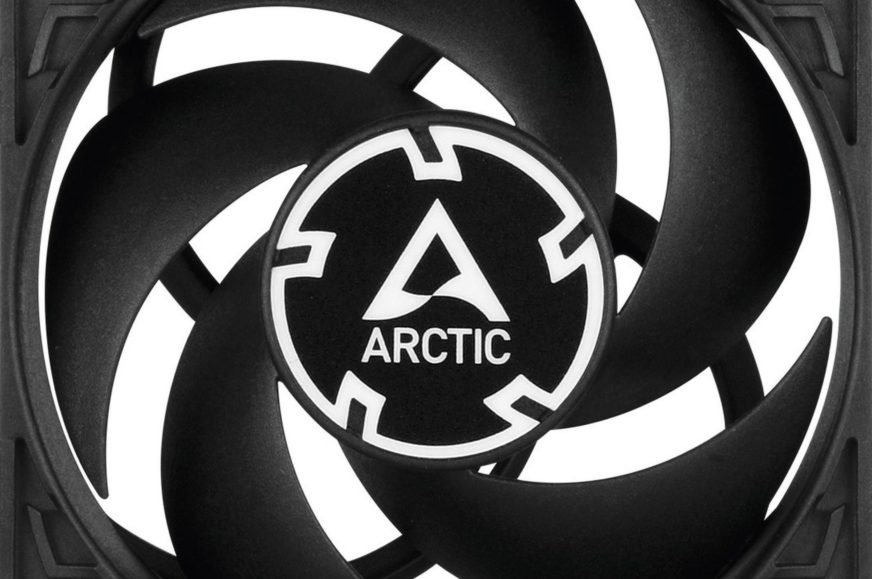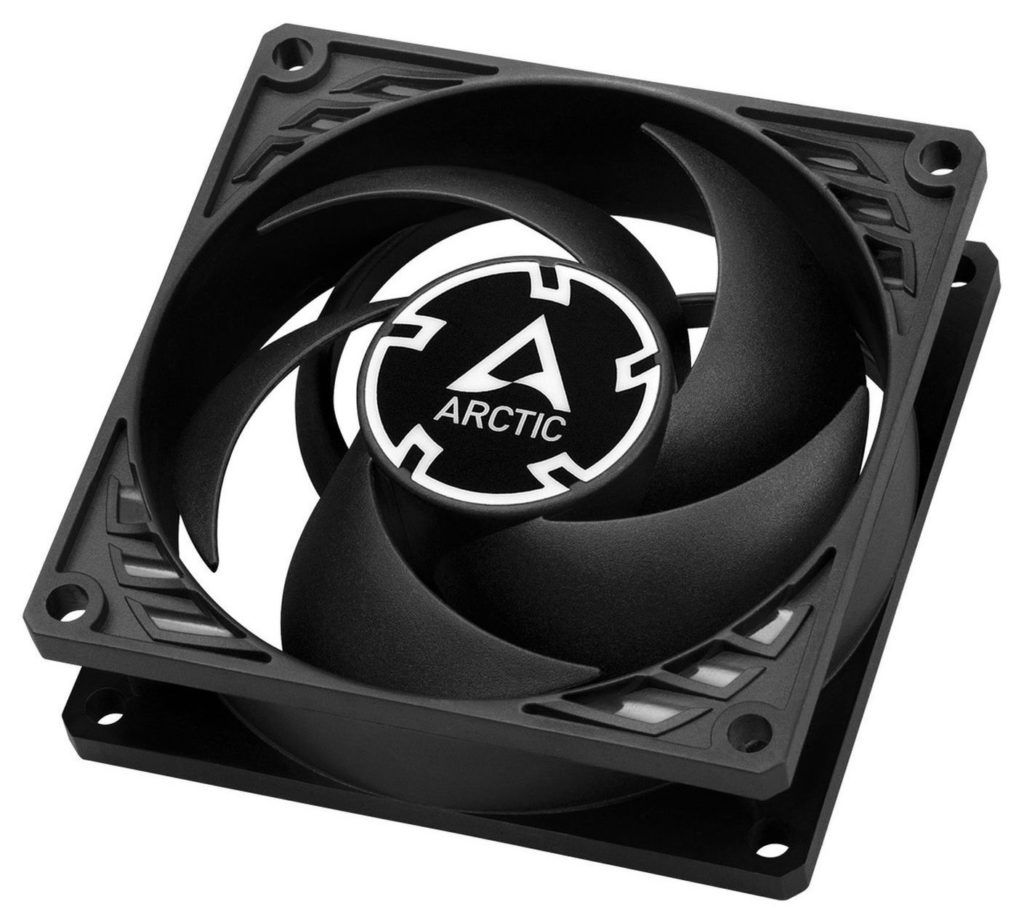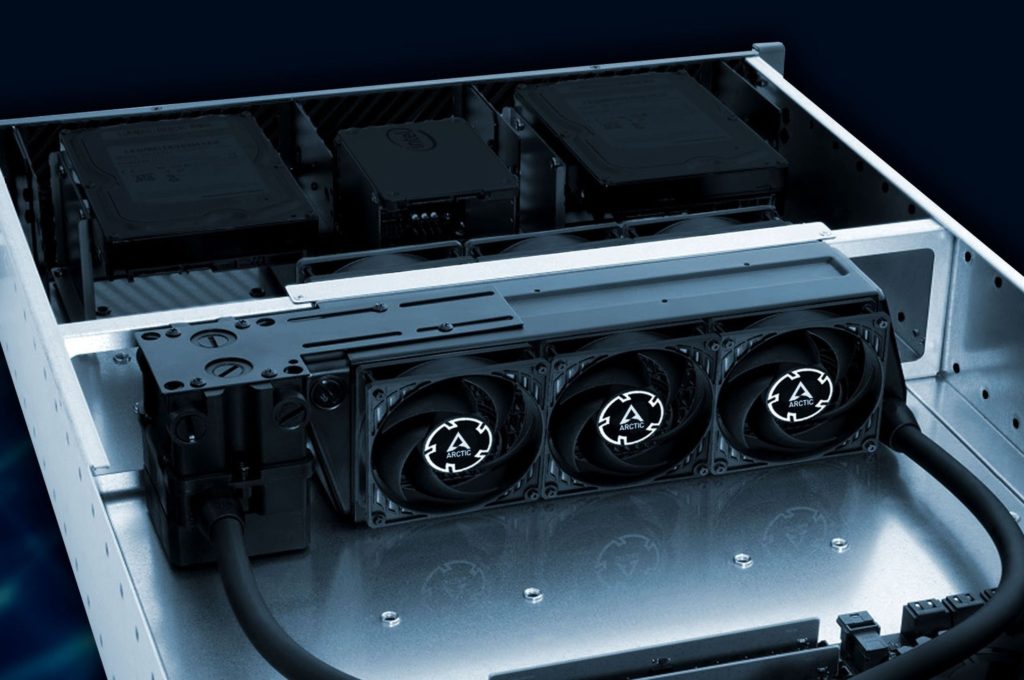Arctic P8 Max
A smaller fan format does not always have to mean low airflow. To achieve comparable results to larger cross-section models, there needs to be higher rpms and with them higher noise levels, but as long as you accept this, and you don’t really have much choice due to the size constraints, the new P8 Max fan seems like an attractive option. And most importantly, it’s one of the few of its kind.
Arctic has had the P8 fans with efficient geometry for some time now. Compared to F models, these also stand out due to their high static pressure, so the airflow drop through an obstacle is slower. In addition to the three older models with DC control (one without a moniker, TC and Silent) and one that supports PWM (PST) there’s now the „Max“ variant.You already know that one from the P12 series and one of its distinguishing features is its significant speed increase compared to the other models. This also applies to the P8 Max.
Unlike the 3000-rpm P8 (TC), the maximum here ends up at 5000 rpm, at which Arctic advertises an airflow of 67.96 m³/h , which is almost on par with the 140-millimeter Fractal Design Silent R3 fan (albeit at an incomparably higher noise level), and we still had thoughts running through our heads that Arctic was understating the P8 Max’s airflow in the specs. Assuming BeQuiet! or Noctua aren’t too wrong, it seems pretty unlikely that a fan of this design would be significantly below the Pure Wings 2 (BeQuiet!) or NF-A8 (Noctua) at the same speed. The static pressure is stated very high for the P8 Max (5.3 mm H2O) , which is natural as the smaller the format, the higher the static pressure per unit of airflow. Because there is less space left for air stream leaks.
Unlike the other P8 fans – and this is the second distinctive feature of the Max variants – this one has ball bearings in two rows (instead of fluid bearings), similar to the CO variants. This is mainly a measure for achieving high durability even at extremely high speeds, which means it will (compared to non-Max models) be a longer distance runner even at equal, lower speeds.
The MTTF value is quoted at a minimum of 500 000 hours. Changing the bearings does not mean making the hub bigger as in the comparison of P12 fans (PWM PST and Max), the latter remains the same, i.e. the length of the blades remains the same. And the overall shape as well. Indeed, no hoop has been added, which is characteristic of the larger P12 Max. Vibrations are unavoidable at high rpm (without or with the hoop), and one can only hope that this fan avoids frequencies that would produce unpleasant tonal peaks. High noise is a certainty, but we can assume that the a hoop would not reduce it and, on the contrary, shorter blades would have to be used as a result, with a negative impact on airflow.
Otherwise, it is an 80 mm fan with standard thickness (25 mm) and let’s mention that it is supposed to start at 500 rpm and passive mode is also supported, into which the fan switches at a low enough PWM duty cycle (according to Arctic’s materials from 5%). Because of their size, these fans are just right for 2U racks and will do a good job on liquid cooler radiators as well.
The official price for the P8 Max on arctic.de is 12.99 EUR including VAT, but we can assume that it will be cheaper in third-party stores. As is generally the case with Arctic products. The fan is only available in one variant – a solo pack in black for both the rotor and the frame.
English translation and edit by Jozef Dudáš
- Contents
- Arctic P8 Max














It is really unexpected that Arctic releases “Max” variant of P8. P8 Max may compete with industrial fans from Delta, Sunon, Sanyo Denki and more. But I’m not sure that P8 Max will have enough superiority of noise-performance efficiency. There is literally no comparable airflow test results about 80mm fans. (Or, I haven’t found them yet.)
For small size, industrial fans often have more advantage for noise-performance, because their manufacturers have very strong ability of development and have spent a long time developing small fans for heavy-duty applications.
I hope the next one is P9. Currently, Arctic only has the old F9 series and I found that F8 has a mediocre efficiency among 92mm fans. Currently, F9 series have only a value for price per piece.
With 92 mm fans I wonder from time to time if they are not already in the pre-death phase. Maybe I’m wrong (and it’s just a feeling), but it seems to me that there are fewer and fewer of them. Similarly, the number of coolers, cases or power supplies (SFX-L) that used to use 92 mm fans is decreasing as now they have 120 mm fans in them (although some of them are only low-profile). From this perspective, it makes sense to me that Arctic has given the “P rotor” preference in the 80 mm format, which is perhaps more in demand in the server environment (in 2U racks) than 92 mm in 3U/4U racks. But this is just my speculation, I don’t have any data, I just wonder why Arctic doesn’t go with P9 and instead they have five P8 models in their offer. 🙂
I just checked how many 92mm and 80mm products available in my region, and it seems that you’re right. The number of 80mm products(~240) is much larger than that of 92mm fans(~130). This may reflect the difference of demand for each factor.
Actually, I thought 92mm fans will have more applications than 80mm before, because 92mm fans have more usage(but still, very narrow) in PC than 80mm. I don’t know well about servers and workstations.
But anyway, I just want to see the competition between NF-A9, TL-B9 and P9. haha